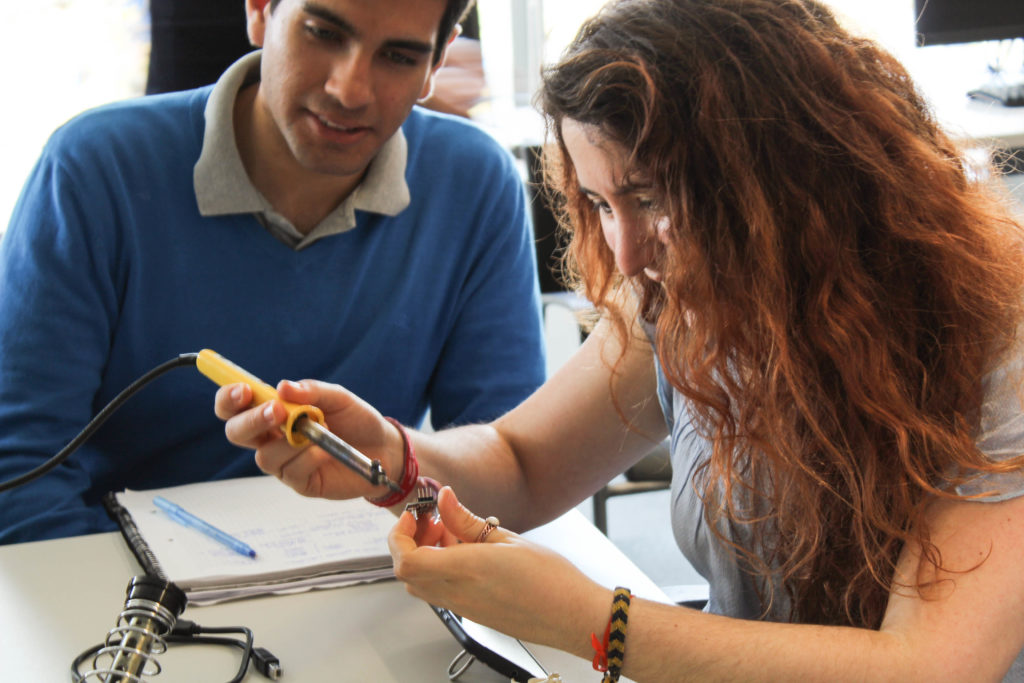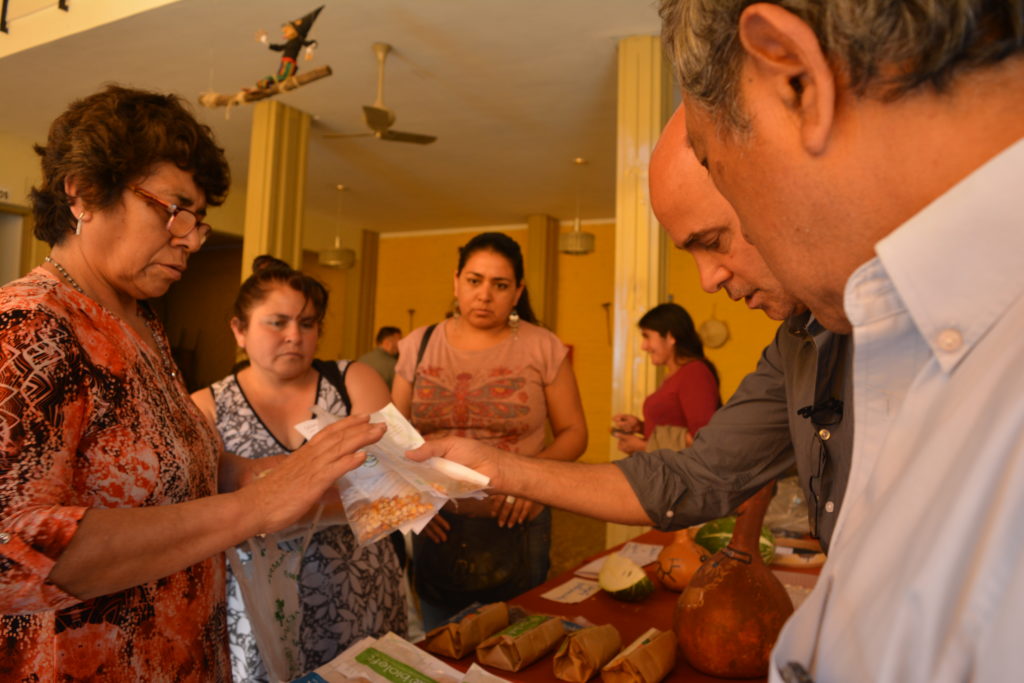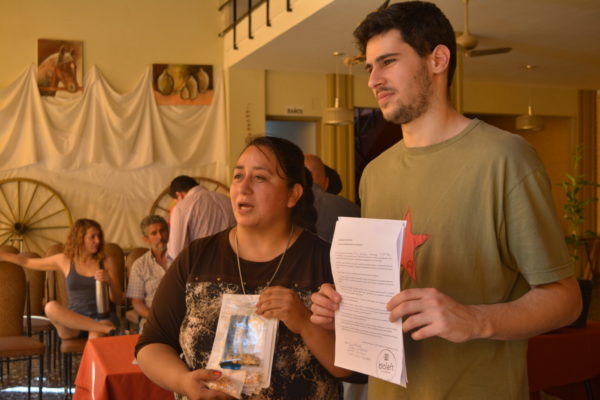By Mariano Fressoli, Patrick Van Zwanenberg and Anabel Marin
One of the key ideas of the open source movement is that by protecting knowledge with a reciprocal or ‘viral’ copyleft license we can ensure unhindered access to that knowledge, and its continual circulation and improvement amongst a community who agree to always share. The copyleft license has been central to creating ‘protected commons’ for some forms of digital knowledge, particularly for software code, as well as the decentralized networks, lack of rigid hierarchies and freedom of information associated with its use and improvement. But what happens when you try to transfer open source ideas beyond the digital world? In September we organized a workshop on open hardware and immediately afterwards an event on open seeds. Some of the difficulties involved in transferring open source ideas from virtual to more material settings, and from communities of practitioners comfortable with networked, digital culture, to those that are less so, were readily apparent.
The open hardware workshop was held at the Centro Cultural de la Ciencia in Buenos Aires, part of a series of events on open science organized by the Ministry of Science, Technology and Innovation, Cientópolis and our institution, Fundacion Cenit. About 50 scientists, science teachers, librarians and hackers participated in an introduction to open hardware for science. Guided by Fernando Castro, an electronic engineer from Mendoza and a participant in the Gathering of Open Hardware for Science, the group built and tested a small light sensor from a ready-made kit. It was a practical way to learn about some of the benefits of open hardware: the lower costs of instruments, the democratization of knowledge, flexibility of use, and the ability to take advantage of a huge library of open code and designs. As Fernando explained, one of the interesting things about open hardware is that a great deal of open knowledge already exists with which to begin experimenting and building your own equipment. For small, general purpose instruments such as microscopes, air monitor sensors, small robotics and so on, there is no need to invent the wheel. It is possible just to use available open data repositories. This is no small matter if you lack the resources to buy what is typically expensive commercial scientific equipment or if the instruments that you need are simply not available in domestic markets. Open hardware provides the opportunity to overcome some of those obstacles, so long as you have a minimum level of capabilities and resources. Despite the fact that most participants at the workshop were new to experimenting with open hardware, most possessed that minimum level of capabilities. Several participants were able to code software and to work with electronics and almost everybody was aware of open source ideals and ways of working. It was easy to introduce the benefits of open hardware, even though most people had never seen an Arduino open hardware micro-controller before.


The following day we travelled to San Pedro de Colalao in the Province of Tucuman, a semi-rural part of northern Argentina, to a workshop where we were presenting Bioleft – a project on open-source seed innovation, developed by Cenit in association with public sector seed breeders. We were meeting representatives from national organizations of small farmers and indigenous peoples, and the idea was to both introduce the project and to begin an exchange of seed varieties from breeders to farmers, under an open source license, for a programme of participative breeding. The open source license, modelled on the idea of copyleft, ensures that access to germplasm, for the purposes of further breeding and development of new seed varieties, will always be unrestricted. The license prevents anyone from exclusively appropriating genetic material that is part of a Bioleft-protected commons, for example with patents, in ways that restrict the use of that material for further breeding. At the same time, the idea of Bioleft is to support a form of peer to peer seed breeding, between small farmers and public sector breeders, using a web-based digital platform. If Bioleft is successful, it will eventually present an alternative to the kinds of seeds that are available from the private sector, which are bred for larger, commercial forms of production, and are for the most part unsuitable for small farmers.
As the workshop progressed, some of the challenges of putting into practice an open source license for participative seed breeding become more and more evident. Small farmers were some distance away, physically and culturally, from the geek public who attended the event at the Centro Cultural de la Ciencia in Buenos Aires the previous day. Most were unfamiliar with open source practices, such as the notion of the viral copyleft license, or had much in the way of experience with digital social networks. Small farmers usually have a cell phone and use WhatsApp, when they can get an internet connection, but they rarely use e-mail. The practical difficulties of trying to get small farmers, dispersed all over the country, to work together with university-based seed breeders in distant locations, via a virtual web platform, rather than through face to face contact, even if assisted by local extension workers, are rather substantial.
And yet, the ideals and practices of sharing embodied knowledge amongst communities of small farmers and communities of open source enthusiasts are very similar. Sharing seeds as a way to diffuse, improve and adapt tools (i.e. seed) are, in theory, quite similar to the reasons for sharing software code or scientific knowledge. Farmers share their artifacts under reciprocal arrangements, hoping to access different kinds of seeds and to improve the genetic stock of seeds, and they have their own networks, seed fairs and long traditions of doing so. But this is a very different kind of world. The language, technical requirements, and practices are totally different between the digital world of open source and that of traditional seed sharing.

For instance, while the use of copyleft-like open source licenses is well known – though not necessarily widely used – among hackers and scientists, among farmers it is quite a foreign idea. Our audience was well aware that the traditional ‘open commons’ of seeds was under threat, and that firms were able to appropriate seed material that had been developed and nurtured by communities of agricultural producers for hundreds of years. But the idea first proposed by the free/libre software movement, of using intellectual property rights to enforce sharing, and protect against exclusive appropriation, was unfamiliar. Furthermore, for small farmers and indigenous leaders, the idea of signing a contract can be confused with a commercial operation or dealing with a private company. As we tried to explain how the open Bioleft license works, the first instinct of several people in our audience was the fear of being tricked by a mischievous company. The idea that open licenses could protect openness and sharing was also heavily questioned. If the seeds were open to use to everyone, what was to prevent companies appropriating the knowledge embodied in seeds? What would be the benefit of sharing knowledge with people or institutions who do not share the same ideals or sacrifices?
There is a huge gap in practice and language from open hardware for science to open seeds. Such differences point to the need to focus not only on developing technical tools and capabilities but also on communication and trust. It took some time to explain the details of Bioleft, and it will inevitably require further encounters and the development of new, more didactic tools in order to describe how the idea of the Bioleft license works, and to modify and put into practice a web platform for participatory breeding. That process of communication will need to be genuinely reciprocal, so that farmers’ ideas, practices and metaphors about sharing and common ownership articulate with those that have arisen in digital cultures. Furthermore, Bioleft will probably not work as a disembodied ‘idea’ and set of legal and digital tools, that anyone can choose to adapt and use. Instead as a practice it will require a governance structure, and that structure will have to comprise the communities of breeders and farmers who seek to experiment with and use open source ideas in seed breeding.

To move from the idea of protected commons to protected seed commons will require the resolution of a new set of challenges, spanning communication, engagement, infrastructure and strategy. Those challenges are substantial, but so is the need to transcend and widen the niche of the new digital commons in order to embrace more traditional commons practices. To move forward in rural environments will require nurturing more than viral spreading. As with producing and growing seeds, transformations require time and care.
